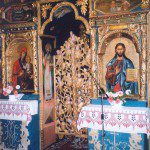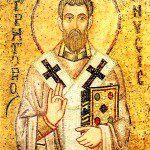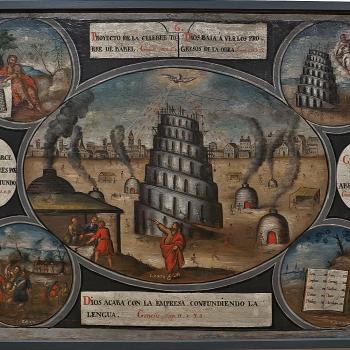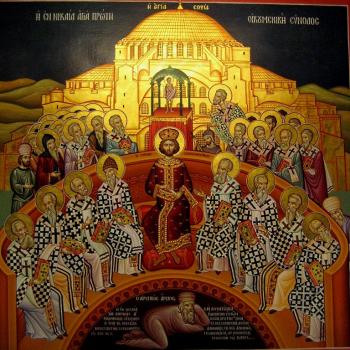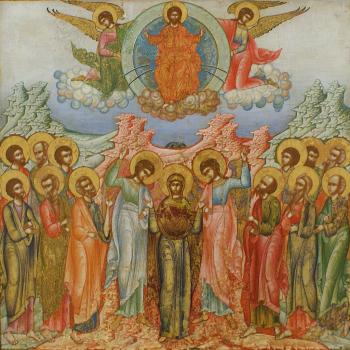![Stoning of St. Stephen. Photograph of icon by ChristianeB (Own work) [CC BY-SA 3.0 (http://creativecommons.org/licenses/by-sa/3.0)], via Wikimedia Commons](https://wp-media.patheos.com/blogs/sites/637/2016/12/Lapidation_de_saint_Etienne_Filotheos_Skoufos-263x300.jpg)
In this manner, the celebration of the birth of Christ coincides with the celebration and remembrance of death. This is as it should be, because it reminds us of the link between birth and death, as well as death with the new and eternal birth in Christ.
Everyone who is born will die. Death is intricately linked to birth. Indeed, it could be said that a cause of death is birth itself, because if someone had not been born, they would not die. Temporal life itself is life which is mixed with death, where we not only know that our temporal, earthly existence will one day come to an end, but also, in every moment, we are found dying and coming back to life, changing in and through such life in death, as St. Gregory Palamas contemplated:
Death was thus to become the lot of our forefathers, just as it lies in store for us who are now living, and our body was rendered mortal. Death is thus a kind of protracted process or, rather, there are myriads of deaths, one death succeeding the next until we reach the one final and long-enduring death. For we are born into corruption, and having once come into existence we are in a state of transciency until we cease from this constant passing away and coming to be. We are never truly the same, although we may appear to be so to those who do not observe us closely. Just as a flame that catches one end of a slender reed changes continually, and its existence is measured by the length of the reed, so we likewise are changing, and our measure is the length of life appointed to each of us.[3]
Temporal life is a living death; to be born is to be born unto death. The way we experience this condition can be said to be the result of sin, as St. Bonaventure explained. “Lastly, because man chose to be separated from the good of the mind on account of the good of the flesh, the soul is unwillingly separated by the just judgment of God from its body by death and dissolution into dust.” [4]
This living death of temporal existence is a curse, because it is founded upon and established as a consequence of sin, but also, it is a mercy. It is a curse, because now when we die, when we come to the end of our temporal existence, we lose our center of being, and our soul and body, which were meant to be together as one, find themselves separated through the division and destruction of nature which sin has handed over to it. Nonetheless, it is also a mercy, because it means there is a limit to what evil we can do, a limit to the sin and suffering we can cause for ourselves and others. The blessing also comes about because it is an opportunity for change, for spiritual purification, if we accept the transformative powers established in death by the death and resurrection of Jesus Christ.
But, if we explore this deeper, then we shall see as St. Gregory Palamas explained: every moment of our life is itself transferred over to death, and partakes of and participates in the final death which comes at the end of our temporal existence, so that in each and every moment, the transformative powers of death are also to be found. That is in each and every moment of time, the graces Jesus made available to us by his death are able to be taken in by us, accepted by us, and through them we can find ourselves participating in the living death which is found in temporal existence, allowing us to partake of the purifying fire of death in our daily life and so be made holy in life itself.
Because we are living out death in our temporal life, we do not have to remain as we are, we can die to the self, die to all the imperfections, and let the dead self bury our dead sin with it as we emerge in new life, a life in which we do not have to let the taint of the past entomb us in the present. Our constant living death allows for change, change for the better, but we must always keep in mind there is one lingering final, eschatological, death which lies in wait for us. When we come to it, we will exit temporal existence and enter into eternity. This, we find, was a part of the message of St. Paul, as St. Nicodemus of the Holy Mountain understood it:
Remember, that according to the Apostle: “The form of this world is passing away, and those who deal with the world [live] as though they had no dealings with it” (1 Cor 7:31). Remember also, “We look not to the things that are seen but to the things that are unseen; for the things that are seen are transient, but the things that are unseen are eternal” (2 Cor 4:18). For death comes and death is unknown. Judgment follows death and this judgment is quick. [5]
We can prepare for our temporal end by the way we engage our living death. We must prepare for it, knowing it is to come, so that in and through it we can emerge, resurrected unto eternal life with a glory that has no end.


